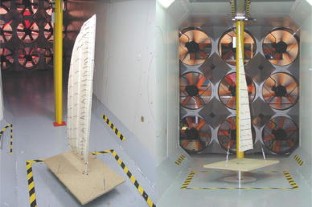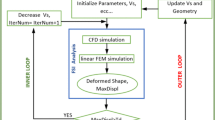Abstract
A study of a boat's motion is carried out in order to analyze the aerodynamic properties of the optimal sail for obtaining the maximum velocity when sailing to windward. The mechanics study shows the optimal C L and C D for a given sail and how the shape of the aerodynamic polar of the sail should be. A parametrical analysis of the aerodynamics of a sail is then carried out varying the maximum camber, position of the maximum camber in the chord direction and position of the maximum camber in the mast direction. The parametric analysis is done numerically with a vortex lattice method (VLM) and experimentally in a wind tunnel. The results show that the influence of the relevant parameters studied can be reduced to the variation of two parameters, A and B, defining the polar of the sail, C D = B + A 2 C L 2; and the influence of parameters A and B on the maximum VMG obtainable are calculated.



































Similar content being viewed by others
Abbreviations
- A :
-
coefficient of the polar of the sail defined as \( C_{{\text{D}}} = B + A^{2} C_{{\text{L}}}^{2} \)
- b :
-
sail span
- B :
-
coefficient of the polar of the sail defined as \( C_{{\text{D}}} = B + A^{2} C_{{\text{L}}}^{2} \)
- C :
-
profile chord
- C D :
-
drag coefficient
- C Hx :
-
hydrodynamic force coefficient in the direction normal to the yacht speed
- C Hy :
-
hydrodynamic force coefficient in the direction of the yacht speed
- C L :
-
lift coefficient
- C Lopt :
-
optimal sailing lift coefficient
- C M :
-
heeling moment coefficient made dimensionless with the apparent wind velocity
- \( C_{{\text{M}}}^{*} \) :
-
heeling moment coefficient made dimensionless with the true wind velocity
- C r :
-
chord of the root section of the sail
- C t :
-
chord of the tip section of the sail
- D:
-
drag
- \( \vec F_{\rm A} \) :
-
aerodynamic force
- \( \vec F_{{\text{\rm H}}} \) :
-
hydrodynamic force
- Fn :
-
Froud number, \( F_{n} = \frac{{\left| {\vec V_{s} } \right|}}{{\sqrt {gD_{{\text{h}}} } }} ,\) where g is the gravity and D h is the characteristic length scale of hydraulic depth
- K :
-
\( \frac{{\rho _{{{\text{H}}_{ 2} {\text{O}}}} S_{{\text{H}}} }}{{\rho _{{\text{a}}} S_{{\text{A}}} }} \)
- L:
-
lift
- m:
-
maximum camber of the profile expressed as a percentage of its chord length
- m τ :
-
slope of the twist profile
- Rn A :
-
aerodynamic Reynolds number, \( R_{{n{\text{A}}}} = \rho _{a} \frac{{\left| {V_{{\text{A}}} } \right|\bar C_{{\text{A}}} }}{{\mu _{{\text{A}}} }} \), being \( \bar C_{{\text{A}}} \) the media chord of the sail and μ A the dynamic viscosity of the water
- Rn H :
-
hydrodynamic Reynolds number, \( R_{{{\it{n}\text{H}}}} = \rho _{{{\text{H}}_{ 2} {\text{O}}}} \frac{{V_{{\text{s}}} L_{{{\text{hull}}}} }}{{\mu _{{{\text{H}}_{ 2} {\text{O}}}} }}, \) being L hull the length of the hull and \( \mu _{{{\text{H}}_{ 2} {\text{O}}}} \) the dynamic viscosity of the air
- S A :
-
characteristic area of the sail
- S H :
-
characteristic area of the hull
- \( \overrightarrow {V_{{\text{A}}} } \) :
-
apparent wind speed
- VMG:
-
Velocity Made Good
- V mg :
-
velocity made good
- \( \overrightarrow {V_{{\text{S}}} } \) :
-
yacht speed
- \( \overrightarrow {V_{{\text{T}}} } \) :
-
wind speed
- ρ a :
-
air density
- \( \rho _{{{\text{H}}_{ 2} {\text{O}}}} \) :
-
water density
- α :
-
angle of attack of the sail
- λ :
-
drift angle
- η A :
-
aerodynamic efficiency of the sail
- η H :
-
hydrodynamic efficiency of the hull
- η m :
-
location of the profile with maximum camber along the mast direction as a percentage of the sail span
- ξ m :
-
location of the maximum camber along the chord of the profile expressed as a percentage of the chord
- μ :
-
taper ratio
- τ :
-
twist angle of each profile
References
Jackson PS (1985) The analysis of the three-dimensional sails. In: Proceeding of the 10th Canadian congress of applied mechanics
Malpede S, Vezza M (2000) Developments of an interactive sail design method. Acta Polytech 4:66–74
Sugimoto T (1996) Theory for inextensible and high aspect-ratio sails. J Wind Eng Ind Aerodyn 63:61–75
Couser P (1998) Computational methods for investigating sail forces—a case study. Yacht Vision ‘98, Auckland, New Zealand, 29th January–1st February
Locke NJ, Jackson PS (1996) Lift and drag distributions of yacht sails using wake surveys. J Fluid Eng 118:346–351
Sparenberg JA, Wiersma AK (1976) On the maximum thrust of sails by sailing close to wind. J Ship Res 20:98–106
Flay RGJ, Locke NJ, Mallinson GD (1996) Model test of twisted flow wind tunnel designs for testing yacht sails. J Wind Eng Ind Aerodyn 63:155–169
Flay RGJ (1996) A twisted flow wind tunnel for testing yacht sails. J Wind Eng Ind Aerodyn 63:171–182
Marchaj CA (1979) Aero-hydrodynamics of sailing. Adlard Coles, London
Wood CJ, Tan SH (1978) Towards an optimum yacht sail. J Fluid Mech 85:459–477
Jackson PS (1996) Modelling the aerodynamics of upwind sails. J Wind Eng Ind Aerodyn 63:17–34
Margason RJ, Lamar JE, Vortex–lattice FORTRAN Program for estimating subsonic aerodynamic characteristics of complex planforms, NASA TN D-6142, February, 1971
Acknowledgments
This work has been sponsored by the Spanish Consejo Superior de Deportes (CSD) and by the Universidad Politécnica de Madrid (UPM) and is part of a more general endeavour for the study of sails design.
Author information
Authors and Affiliations
Corresponding author
About this article
Cite this article
Laverón-Simavilla, A., Lapuerta, V., Franchini, S. et al. Sail optimization for upwind sailing: application in a Tornado, the Olympic class catamaran. J Mar Sci Technol 13, 190–206 (2008). https://doi.org/10.1007/s00773-008-0007-4
Received:
Accepted:
Published:
Issue Date:
DOI: https://doi.org/10.1007/s00773-008-0007-4




